Friday morning we slept in; it was after ten by the time we stirred, and we were dressed and ready to go out just about in time for lunch. Which turned out to be Schlotzsky’s in Canyon, because Schlotzsky’s (yay Austin!), and it was near the museum we were going to for the afternoon. When we sat down I noticed that the wall near us had an enormous picture of their original location down on South Congress Avenue, at which I had actually bought Schlotzsky’s sandwiches many years back. There’s no longer a Schlotzsky’s there; now it’s an Amy’s Ice Cream location. (Somebody ought to put up a blue plaque or something.)
Another thing that turned out to be Same as It Ever Was was the band camp. There were several groups of high school students in the restaurant wearing lanyards identifying them as attending the West Texas A&M Band Camp, which I attended back in 1973 and ’74. (This is how come I know anything about Canyon at all.) The camp is one of the older ones in Texas, dating to 1952, and is now much tougher to get into than when I went—current-day students have to audition for admission. In my time, you paid your money and you went, and auditions happened on the first day, when they sorted you into which band (there were ten) you were to be a part of.
After lunch we drove back up all two blocks to the museum, which was on a street that I immediately recognized. The commercial storefronts were exactly the same as in the Seventies, although the businesses in them had changed over the years. The museum had changed some, mostly by adding on two new wings in the 1980s, but fortunately the passion for change hadn’t gotten as far as changing the Art Deco façade.
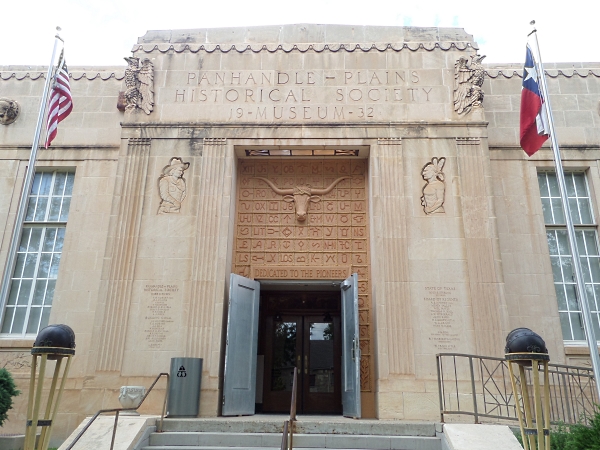
Having the additional wings meant the museum could afford to clear out the entrance hall, and leave room to stand back and admire a series of murals depicting incidents in the history of the Panhandle. It also gave space to set up teaser exhibits for the museum’s main collections: natural history of the Plains, the cattle industry, and the oil industry.
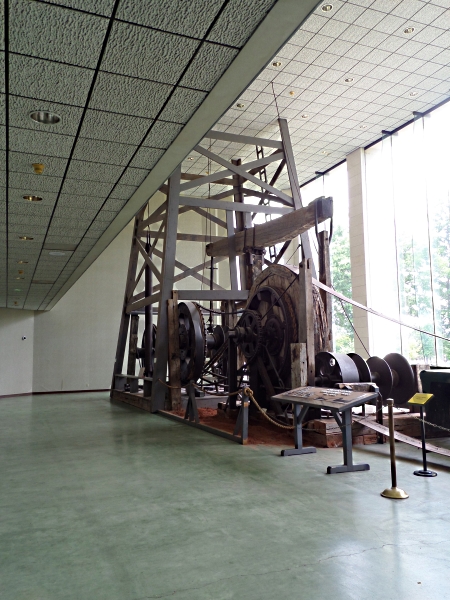
This isn’t to say that there weren’t other big spaces. In the first added wing, put up in 1983, there was a complete oil derrick and its machinery, minus the top three-quarters of the tower, which just was not going to fit into the building.
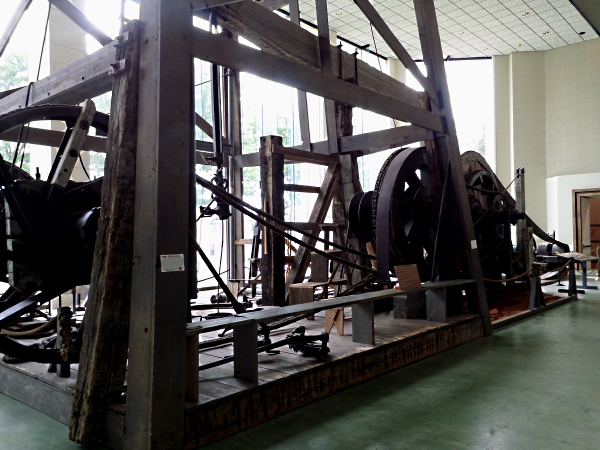
Another hall was devoted to one of the devices that made Plains life possible: the windmill. Their collection isn’t nearly as broad as the windmill museum in Lubbock, but they still had some impressive examples, such as this monster Eclipse mill with a twenty-two foot diameter wheel, used to pump lots of deep water to refill railroad water tanks. This was another exhibit where the ceilings were just too low to allow a full display, but even the bottom half of the wheel is pretty damn impressive.

The exhibit had one mill installed on a partial tower, with a sign inviting visitors to “spin it if you’re tall enough!” L and M were entertained to find that I was tall enough to spin the wheel if I stretched.
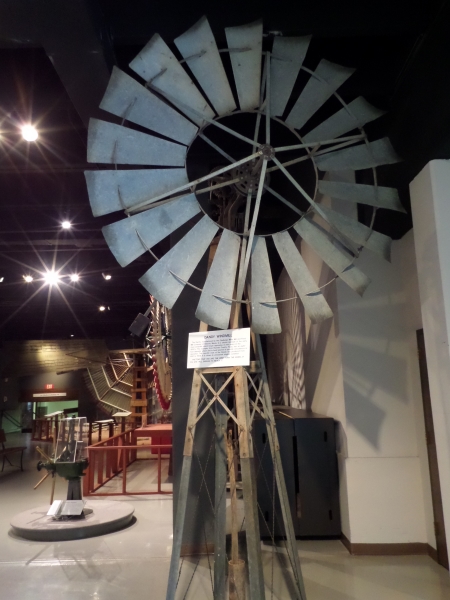
The oil industry exhibits continued throughout the first and second floors. In the entry hall, they had this beautifully restored and rare “dial” gas pump, made by Southwest Pump Company of Bonham, Texas.
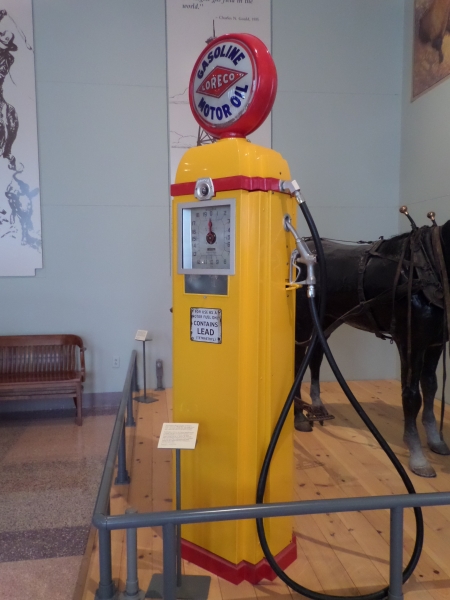
Elsewhere, they had a mocked-up service station of the 1920s, stocked with all the junk that collects at a gas station.
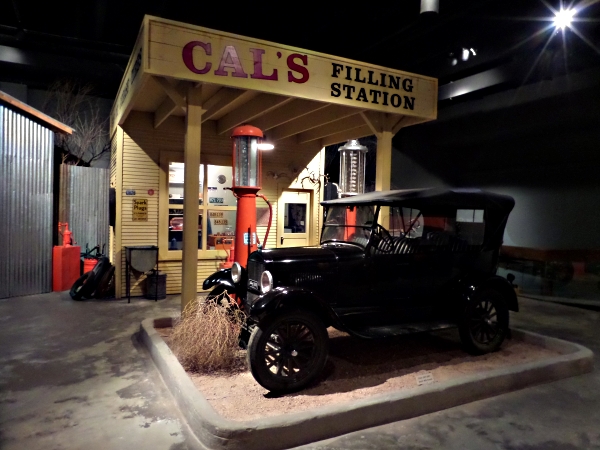
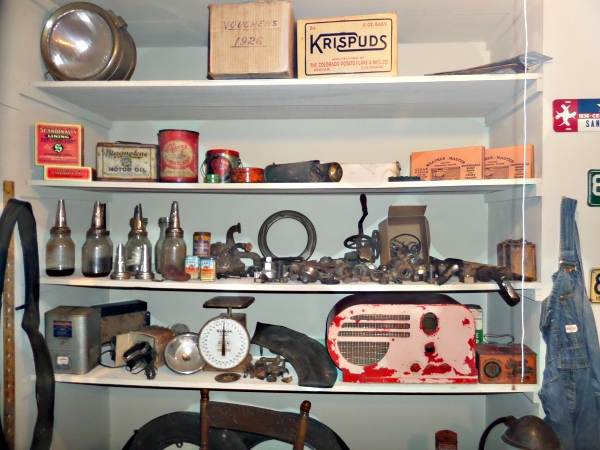
Toward the back, the museum had built a mock “Pioneer Town,” with representative storefronts and contents of a small town in the 1890s. I was especially taken with the bank cashier’s cage, which came from the Panhandle City Bank, now long vanished. Note the frying-pan logo below the cage window, marked with B for “Bank.”

I was less taken by the newspaper/print shop, which had a clanging anachronism in it.

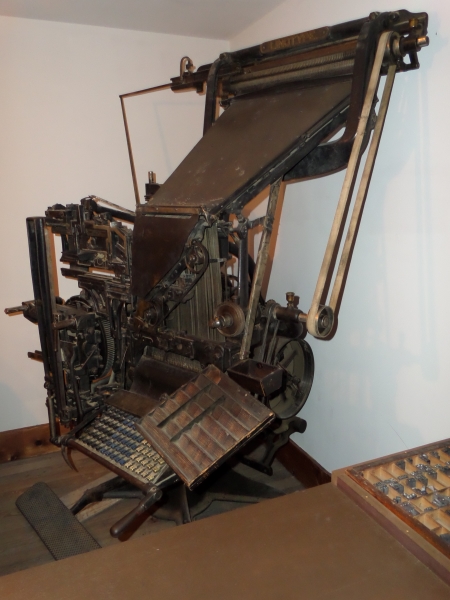
I can just about swallow the Washington hand press; it’s right for a frontier printing operation. What I can’t swallow is the Linotype sitting in the same room with it. Otto Mergenthaler didn’t invent the Linotype until 1884, and the likelihood that one of them would have gotten that far out onto the frontier ten years later is somewhere around nil. The museum would have done far better to trade it to someone for a platen job press, which would have been out on the frontier that early.
So seeing all these things, and a lot of others, used up the afternoon for us, and pretty quickly it was time to drive out to the Palo Duro canyon to see the outdoor musical show Texas. Driving directions were easy: go out Fourth Avenue and keep going for ten miles or so. The show is held at a site in Palo Duro Canyon State Park, and the surroundings are pretty impressive. The Palo Duro was cut by the Prairie Dog Fork of the Red River, and is the second largest canyon in the United States, behind Grand Canyon.
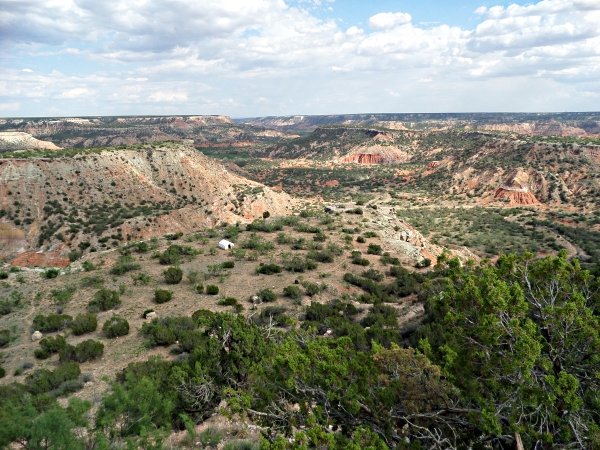
That’s the view from the park’s visitor center, just before you start driving down to the bottom to get to the theater. It’s a snaky ride, full of hairpin turns and dropoffs. L, who pays attention to such things, collected a new steep grade sign: ten percent for a mile. Previously her record had been an eight percent grade in West Virginia.
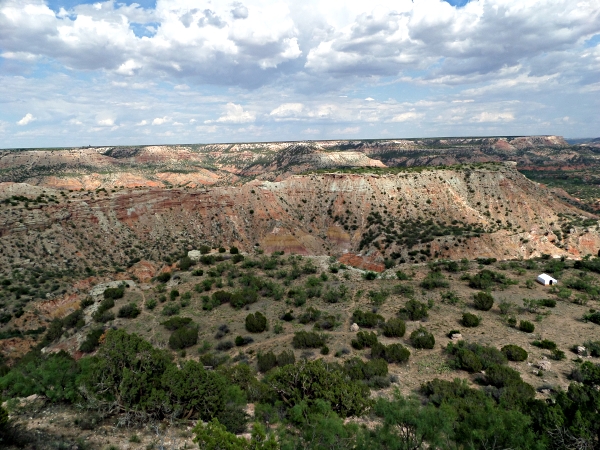
We got down safely, found parking, and went on in. L had the forethought to buy barbecue suppers at the theater for us before the performance, which neatly solved the problem of when and what to eat. The barbecue was really good—it may have been the best thing about the evening. We were serenaded, I guess you would have to call it, while we ate by a band made up of cast members who were no better than fair.

A sampling of the audience before the show. The things you see that look like smoke are water misters, which helped to keep the temperature in the waiting area bearable.
The show’s plot was ultra-predictable, not a lot more complicated than a high-school Winning of the West pageant with some local flavor thrown in. Most of the cast was young and … not green, exactly, but not polished. They had a flavor of earnestness, which I suppose you have to have if you’re going to serve up something like this and not retch.
At this point I need to say that while L and M had never seen this piece before, I had. The production has been going every summer since 1965, and I saw it in seasons eight and nine. We’re now on season forty-eight. When I saw it in the ’70s, the rah-rah and flag-waving was confined to waving the Texas flag. No more.
We got to the point where I remembered the show ending, with the coming of the railroad and the founding of a new town, and the Farmer marrying the Ranch Tycoon’s niece and everyone generally burying the hatchet (and not Quanah Parker’s hatchet, either; he got dragged into this thing by the scruff of his neck). It didn’t end. Instead, we got ten minutes more of unadulterated nativist, Know-Nothing jingoist rah-rah, all wrapped in the American flag (they had plenty to choose from; I think there were six being carried round the stage) and fireworks and a Bellagio-manqué fountain display that they’d had to cook up a couple of years back when wildfire danger was too great to use fireworks, and liked so much they kept it when the fire danger slacked off. All they lacked was Uncle Sam and an eagle. It was the worst kind of pandering to the worst parts of patriotism, and the audience loved it. I was appalled.
As soon as the lights went up, I jammed on my hat and stalked out before I threw something. (I couldn’t find where I had stashed the bag of rotten eggs and tomatoes, anyway.) I had to stand at the back of the theater and steam until L and M could manage to get through the crowd, several minutes later. We finally did get outside, L shushing me every time I rumbled for fear of a Vesuvian event. Then we had to sit for most of half an hour until we could get a place in line on the road out. It’s been a long time since I was that disgusted by a performance, but that bunch succeeded in the biggest kind of way. I don’t think that even the museum, interesting as it was, could possibly make me want to go back.
But we finally got out of the canyon, hopped onto I-27 back to Amarillo and our hotel. Saturday was going to be our last day out, and we were ready to get home.

3 Responses to Go west, young man: 2013 vacation, Day 14